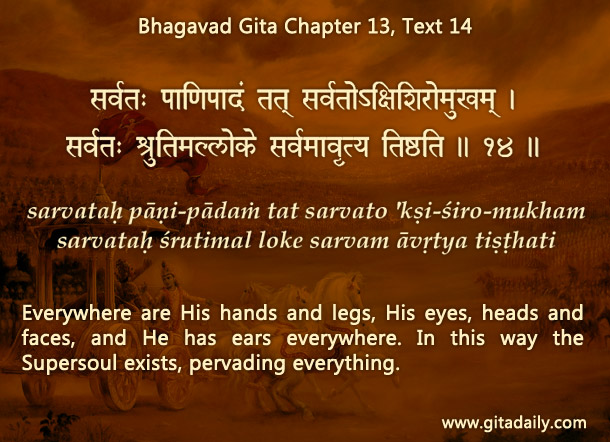In the Bhagavad-gita’s thirteenth chapter (13.14), Krishna talks about divine omnipresence in remarkably personal terms: everywhere are his hands, legs, eyes, heads, faces and ears. What does this description mean?
In the Gita’s narrative context, this could refer to the universal form, which too was described in vividly personal terms (11.10-11). In the Gita’s philosophical context, it could refer to the indwelling Supersoul, who too has a form with limbs. In Arjuna’s personal context, this could have a much more immediate implication.
As all living beings are parts of Krishna (15.07), that means Arjuna too is a part of Krishna. When Krishna urges Arjuna to become his instrument in the war (11.33), he is essentially asking Arjuna to become a part of Krishna’s mission to establish dharma in the world (04.07-08). Pertinently, Srimad-Bhagavatam (10.90.48) declares that Krishna neutralizes ungodly elements sometimes with his own hands and sometimes with others’ hands. Commentators explain that these other hands refer to the hands of the Pandavas, especially Arjuna, who carried out Krishna’s will through the Kurukshetra war.
Echoing this devotional theme through historical narrative, the Mahabharata tradition describes the heroic Babruvahana who was blessed to behold the entire Kurukshetra war. When asked to share his eyewitness account, he replied, “I just saw Krishna with his Sudarshana disc, destroying all the Kauravas.” Given that Krishna didn’t use his Sudarshan disc even once during the Kurukshetra war, Babruvahana’s vision was clearly mystical and devotional: it focused not on the instruments in the fight (the Pandavas), but on the source who empowered them to fight (Krishna).
One-sentence summary:
Krishna’s description of divine omnipresence in personal terms can refer not just to the universal form or the Supersoul but also to his exhortation that Arjuna become a personal instrument in Krishna’s hands.
Think it over:
- What could the thirteenth chapter description of divine omnipresence mean in the Gita’s narrative and philosophical contexts?
- What could that description mean for Arjuna?
- How is the implication that Arjuna was meant to be Krishna’s hands echoed in other scriptures?
***
13.14: Everywhere are His hands and legs, His eyes, heads and faces, and He has ears everywhere. In this way the Supersoul exists, pervading everything.
To know more about this verse, please click on the image


Hare Krishna
Why is Lord Krishna talking about Himself in the third person? As in, “everywhere is His…” instead of “Everywhere is My…”. It is interesting.
Addressed in these two articles:
https://gitadaily.com/krishnas-intriguing-third-person-references-to-himself/
https://gitadaily.com/how-the-third-person-and-first-person-references-point-to-an-evolving-understanding-of-divinity/
Hare Krishna,
PAMHO, All glories to Srila Prabhupada!
Wonderful text prabhu ji, I remember Babruvahana`s answer, I just don`t remember what I was studying at that time.
The Purport on 13.14 in other context is very powerful … The individual soul cannot claim that he is all-pervading. Therefore this verse describes the Supreme Soul, the Personality of Godhead, not the individual soul.
There are people who claim they have such power but this belongs to kind of a psychopathological nature. So it seems to me.
Ys,
Good point, thanks.